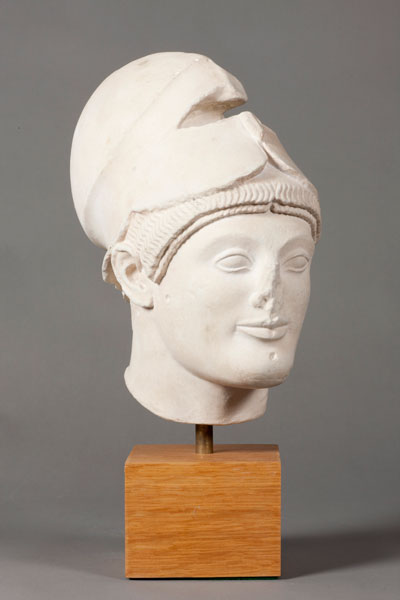
CC13: Warrior
Plaster cast, Ministry of Culture Casts and Reproductions, Greece, 1988
Purchased, 1996
Dimensions: H 29cm
Acc #: CC13, James Logie Memorial Collection
Copy of marble head of a Warrior, c. 500-490 BC
Found at the Propylon of the sancutary of Aphaea on Aegina, 1901. Part of the earlier east pediment group.
National Archaeological Museum, Athens, #: 1933
Style
The original head of a warrior is dated to c.500-490 BC, at a transitional point between the Archaic style and the Severe style. The head displays Archaic features, most evident in the smile. The flat left side of the head indicates that it was part of a relief scene, meant to be viewed only from the right side.
History
The original sculpture was part of the pedimental group of the temple of Aphaea on the island of Aegina, thought to represent Aeginetan soldiers in a battle. It is possible that the warrior represented a combatant in the first or second Trojan War.
The Greek historian Pausanias describes Aphaea as an epithet for the nymph Britomartis, the daughter of Zeus. According to the myth, she flung herself into a fisherman’s net whilst fleeing Minos, and Artemis took her to safety on the Aegean island. Aphaea is thought to mean ‘invisible’. Originally associated with fertility and agriculture, she was later connected with the goddess Athena as well.
The warrior’s approximate date of c. 500-490 BC coincides with the rebuilding of the temple of Aphaea after a fire thought to have occurred in c. 510 BC. Damage sustained by the original bust may correlate to this event.

Side view of the Head of a Warrior

Reverse view of the Head of a Warrior

Front view of the Head of a Warrior

Further Reading
A short selection of references for this work includes:
- Davidson Reid, Jane. 1993. The Oxford Guide to Classical Mythology in the Arts, 1300-1990s. Oxford: University Press
- Greek Ministry of Culture. 1988. Catalogue of Casts and Reproductions. Athens: Archaeological Receipts Fund
- Lullies, Reinhard and Max Hirmer. 1957. Greek Sculpture. London: Thames and Hudson
- Kaltsas, Nikolaos. 2002. Sculpture in the National Archaeological Museum, Athens. Los Angeles: Getty Publications
- Potter, David. 2003. “Hellenistic Religion.” In A Companion to the Hellenistic World, edited by Andrew Erskine, 407-430. Blackwell Publishing
- Ridgway, Brunile Sismondo. 1970. The Severe Style in Greek Sculpture. Princeton: University Press
- Spivey, Nigel. 1996. Understanding Greek Sculpture. London: Thames and Hudson
- Stillwell, Richard, William L. McDonald, and Marian Holland McAllister. 1976. The Princeton Encyclopedia of Classical Sites. New Jersey: Princeton University Press.